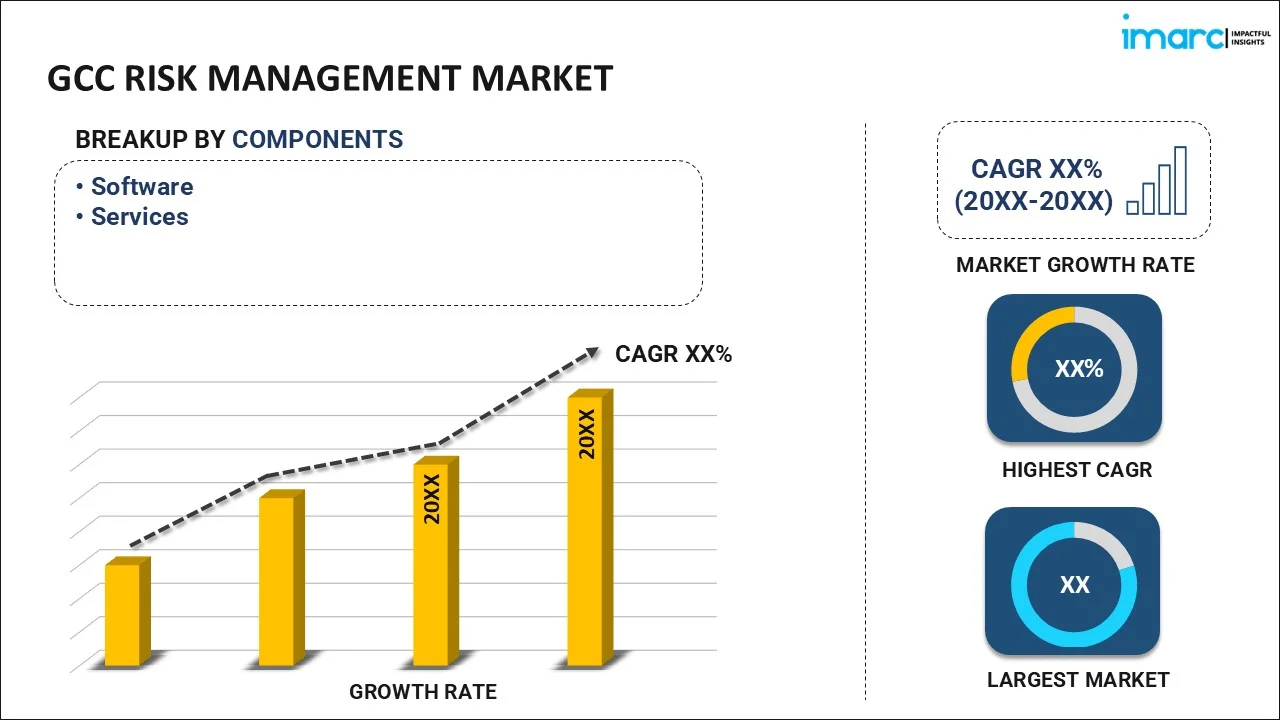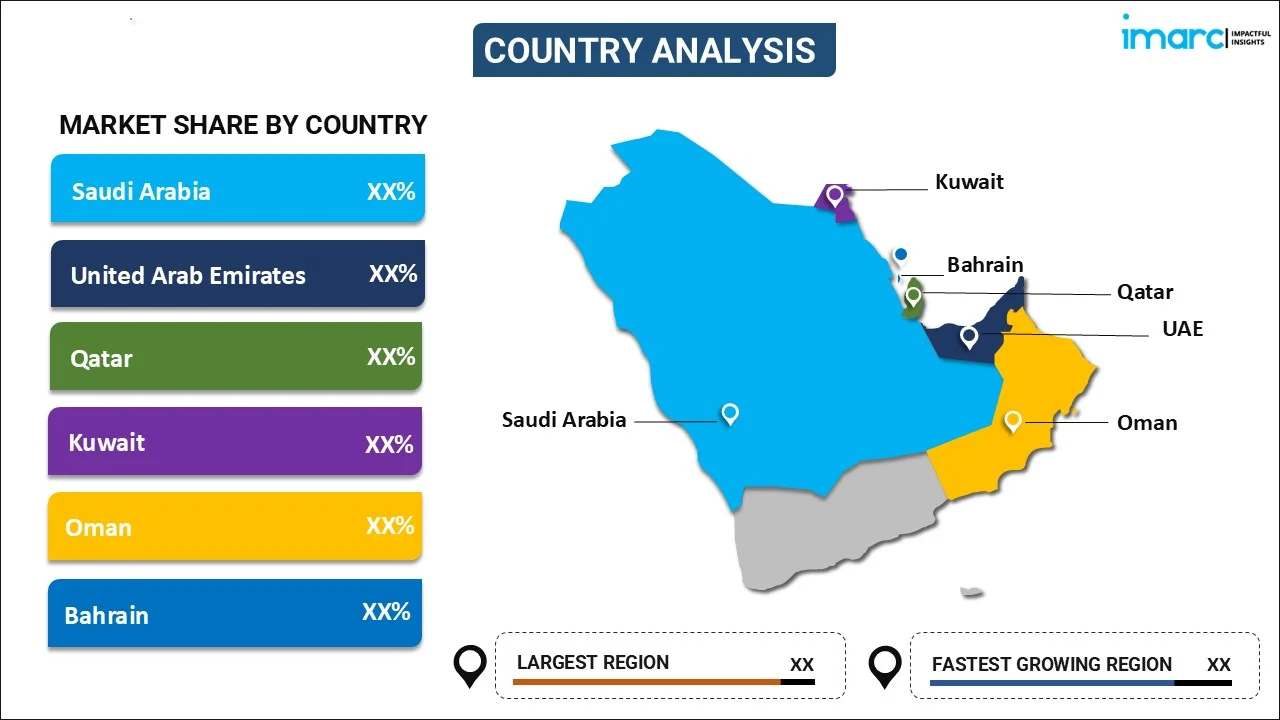
GCC Risk Management Market Report by Component (Software, Services), Deployment Mode (On-premises, Cloud-based), Enterprise Size (Large Enterprises, Small and Medium-sized Enterprises), Industry Vertical (BFSI, IT and Telecom, Retail, Healthcare, Energy and Utilities, Manufacturing, Government and Defense, and Others), and Country 2025-2033
Market Overview:
The GCC risk management market size reached USD 257.0 Million in 2024. Looking forward, IMARC Group expects the market to reach USD 874.0 Million by 2033, exhibiting a growth rate (CAGR) of 14.2% during 2025-2033. The growing adoption in the energy sector due to fluctuations in oil prices and geopolitical uncertainties, increasing awareness about information security and data protection, and rising focus on corporate governance represent some of the key factors driving the market.
|
Report Attribute
|
Key Statistics
|
|---|---|
|
Base Year
|
2024 |
|
Forecast Years
|
2025-2033
|
|
Historical Years
|
2019-2024
|
| Market Size in 2024 | USD 257.0 Million |
| Market Forecast in 2033 | USD 874.0 Million |
| Market Growth Rate (2025-2033) | 14.2% |
Risk management is a method that allows businesses and organizations to identify, evaluate, and address potential threats and uncertainties that could impact their operations. It comprises the identification and analysis of various risks, such as financial, operational, regulatory, geopolitical, technological, and market-related factors, which may pose challenges to businesses. It maintains performance and protects the assets and reputation of an organization. It enables organizations to make informed decisions, enhance resilience, and ensure sustainable growth and success in the highly competitive business landscape. It minimizes the adverse effects of potential risks and allows businesses to follow a structured approach that includes risk identification, risk assessment, risk prioritization, risk mitigation, and ongoing monitoring and evaluation. It also benefits in avoiding legal penalties and fines and enhancing the reputation and credibility of a company. It assists in ensuring the long-term sustainability and growth of a business, reducing the impact of disruptions, and maintaining business continuity. Besides this, it aids in enhancing the ability of a business to withstand and recover from adverse events and uncertainties. As it allows for faster and more efficient problem-solving in challenging situations, the demand for risk management is rising in the GCC region.
GCC Risk Management Market Trends:
At present, the increasing demand for efficient risk management solutions in the energy sector due to fluctuations in oil prices and geopolitical uncertainties in the GCC region represents one of the major factors influencing the market positively. Moreover, the rising adoption of risk management, as it minimizes losses and protects resources from potential threats, is strengthening the growth of the market. Apart from this, the growing focus on transparency and corporate governance to ensure adherence to regulations and industry standards is offering a positive market outlook. Additionally, the rising awareness about the importance of information security and data protection among business organizations is offering lucrative growth opportunities to industry investors in the region. In line with this, the increasing emergence of green risk management solutions to address climate-related risks and promote environmental sustainability is impelling the market growth. Besides this, the rising demand for integrated risk management platforms that can provide real-time monitoring, analytics, and predictive insights, is supporting the growth of the market. In addition, the increasing awareness among organizations to prevent financial losses, improve creditworthiness, and secure better terms for borrowing, is bolstering the growth of the market. Furthermore, the rising utilization of digital technologies, along with the increasing number of cyber threats and data breaches to gather sensitive information about a company, is contributing to the growth of the market in the GCC region.
GCC Risk Management Market Segmentation:
IMARC Group provides an analysis of the key trends in each segment of the GCC risk management market report, along with forecasts at the regional and country levels for 2025-2033. Our report has categorized the market based on component, deployment mode, enterprise size, and industry vertical.
Component Insights:

- Software
- Services
The report has provided a detailed breakup and analysis of the market based on the component. This includes software and services.
Deployment Mode Insights:
- On-premises
- Cloud-based
A detailed breakup and analysis of the market based on the deployment mode has also been provided in the report. This includes on-premises and cloud-based.
Enterprise Size Insights:
- Large Enterprises
- Small and Medium-sized Enterprises
A detailed breakup and analysis of the market based on the enterprise size has also been provided in the report. This includes large enterprises and small and medium-sized enterprises.
Industry Vertical Insights:
- BFSI
- IT and Telecom
- Retail
- Healthcare
- Energy and Utilities
- Manufacturing
- Government and Defense
- Others
A detailed breakup and analysis of the market based on the industry vertical has also been provided in the report. This includes BFSI, IT and telecom, retail, healthcare, energy and utilities, manufacturing, government and defense, and others.
Country Insights:

- Saudi Arabia
- UAE
- Qatar
- Bahrain
- Kuwait
- Oman
The report has also provided a comprehensive analysis of all the major regional markets, which include Saudi Arabia, UAE, Qatar, Bahrain, Kuwait, and Oman.
Competitive Landscape:
The report has also provided a comprehensive analysis of the competitive landscape in the market. Competitive analysis such as market structure, key player positioning, top winning strategies, competitive dashboard, and company evaluation quadrant has been covered in the report. Also, detailed profiles of all major companies have been provided.
GCC Risk Management Market Report Coverage:
| Report Features | Details |
|---|---|
| Base Year of the Analysis | 2024 |
| Historical Period | 2019-2024 |
| Forecast Period | 2025-2033 |
| Units | Million USD |
| Scope of the Report | Exploration of Historical and Forecast Trends, Industry Catalysts and Challenges, Segment-Wise Historical and Predictive Market Assessment:
|
| Components Covered | Software, Services |
| Deployment Modes Covered | On-premises, Cloud-based |
| Enterprise Sizes Covered | Large Enterprises, Small and Medium-sized Enterprises |
| Industry Verticals Covered | BFSI, IT and Telecom, Retail, Healthcare, Energy and Utilities, Manufacturing, Government and Defense, Others |
| Countries Covered | Saudi Arabia, UAE, Qatar, Bahrain, Kuwait, Oman |
| Customization Scope | 10% Free Customization |
| Post-Sale Analyst Support | 10-12 Weeks |
| Delivery Format | PDF and Excel through Email (We can also provide the editable version of the report in PPT/Word format on special request) |
Key Questions Answered in This Report:
- How has the GCC risk management market performed so far and how will it perform in the coming years?
- What has been the impact of COVID-19 on the GCC risk management market?
- What is the breakup of the GCC risk management market on the basis of component?
- What is the breakup of the GCC risk management market on the basis of deployment mode?
- What is the breakup of the GCC risk management market on the basis of enterprise size?
- What is the breakup of the GCC risk management market on the basis of industry vertical?
- What are the various stages in the value chain of the GCC risk management market?
- What are the key driving factors and challenges in the GCC risk management market?
- What is the structure of the GCC risk management market and who are the key players?
- What is the degree of competition in the GCC risk management market?
Key Benefits for Stakeholders:
- IMARC’s report offers a comprehensive quantitative analysis of various market segments, historical and current market trends, market forecasts, and dynamics of the GCC risk management market from 2019-2033.
- The research study provides the latest information on the market drivers, challenges, and opportunities in the GCC risk management market.
- Porter's five forces analysis assist stakeholders in assessing the impact of new entrants, competitive rivalry, supplier power, buyer power, and the threat of substitution. It helps stakeholders to analyze the level of competition within the GCC risk management industry and its attractiveness.
- Competitive landscape allows stakeholders to understand their competitive environment and provides an insight into the current positions of key players in the market.
Need more help?
- Speak to our experienced analysts for insights on the current market scenarios.
- Include additional segments and countries to customize the report as per your requirement.
- Gain an unparalleled competitive advantage in your domain by understanding how to utilize the report and positively impacting your operations and revenue.
- For further assistance, please connect with our analysts.
 Inquire Before Buying
Inquire Before Buying
 Speak to an Analyst
Speak to an Analyst
 Request Brochure
Request Brochure
 Request Customization
Request Customization




.webp)




.webp)












